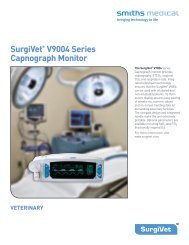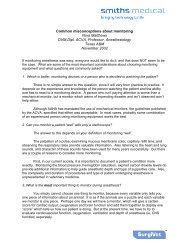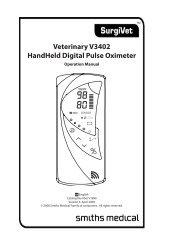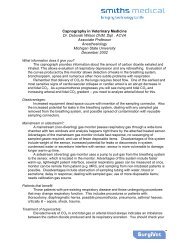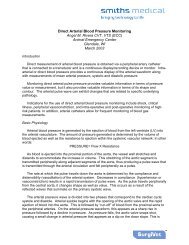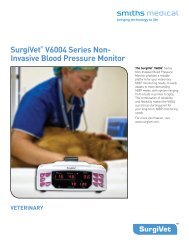Surgivet® V1030 Hand-Held Pulse Oximeter
Surgivet® V1030 Hand-Held Pulse Oximeter
Surgivet® V1030 Hand-Held Pulse Oximeter
Create successful ePaper yourself
Turn your PDF publications into a flip-book with our unique Google optimized e-Paper software.
Appendix A: Guidance and Manufacturer’s Declaration<br />
GUIDANCE AND MANUFACTURER’S DECLARATION – ELECTROMAGNETIC IMMUNITY<br />
The <strong>V1030</strong> pulse oximeter is intended for use in the electromagnetic environment specified<br />
below. The customer or end user of the <strong>V1030</strong> pulse oximeter should ensure that it is used in<br />
such an environment.<br />
IMMUNITY TEST<br />
IEC 60601 TEST<br />
LEVEL<br />
COMPLIANCE<br />
LEVEL<br />
ELECTROMAGNETIC<br />
ENVIRONMENT – GUIDANCE<br />
Portable and mobile RF<br />
communication equipment should<br />
be used no closer to any part of the<br />
<strong>V1030</strong> pulse oximeter, including<br />
cable, than the recommended<br />
separation distance calculated<br />
from the equation applicable to the<br />
frequency of the transmitter.<br />
Conducted RF<br />
IEC 61000-4-6<br />
3 Vrms<br />
150 kHz to 80 MHz<br />
3 Vrms<br />
Recommended separation distance:<br />
d = 1.2√P 150 kHz to 80 MHz<br />
Radiated RF<br />
IEC 61000-4-3<br />
3 V/m<br />
80 MHz to 2.5 GHz<br />
2 Hz Modulation<br />
3 V/m<br />
d = 1.2√P<br />
d = 2.3 √P<br />
80 MHz to 800 MHz<br />
800 MHz to 2.5 GHz<br />
20V/m<br />
80 MHz to 2.5 GHz<br />
1 kHz Modulation<br />
20V/m<br />
d = 0.18√P<br />
d = 0.35 √P<br />
80 MHz to 800 MHz<br />
800 MHz to 2.5 GHz<br />
where P is the maximum output<br />
power rating of the transmitter<br />
in watts (W) according to the<br />
transmitter manufacturer and d<br />
is the recommended separation<br />
distance in meters (m).<br />
Field strengths from fixed RF<br />
transmitters, as determined by an<br />
electromagnetic site survey, a should<br />
be less than the compliance level in<br />
each frequency range. b<br />
Interference may occur in the<br />
vicinity of equipment marked with<br />
the following symbol:<br />
4<br />
Note 1 At 80 MHz and 800 MHz, the higher frequency range applies.<br />
Note 2 These guidelines may not apply in all situations. Electromagnetic propagation is affected by<br />
absorption and reflection from structures, objects and people.<br />
a Field strengths from fixed RF transmitters, such as base stations for radio (cellular/cordless) telephones<br />
and land mobile radios, amateur radio, AM and FM radio broadcast and TV broadcast cannot be predicted<br />
theoretically with accuracy. To assess the electromagnetic environment due to fixed RF transmitters, an<br />
electromagnetic site survey should be considered. If the measured field strength in the location in which<br />
the <strong>V1030</strong> pulse oximeter is used exceeds the applicable RF transmitter compliance level above, the <strong>V1030</strong><br />
pulse oximeter should be observed to verify normal operation. If abnormal performance is observed,<br />
additional measures may be necessary, such as reorienting or relocating the <strong>V1030</strong> pulse oximeter.<br />
b Over the frequency range 150 kHz to 80 MHz, field strengths should be less than 3 V/m.<br />
Veterinary <strong>V1030</strong> <strong>Hand</strong>-<strong>Held</strong> <strong>Pulse</strong> <strong>Oximeter</strong> Operation Manual A-3


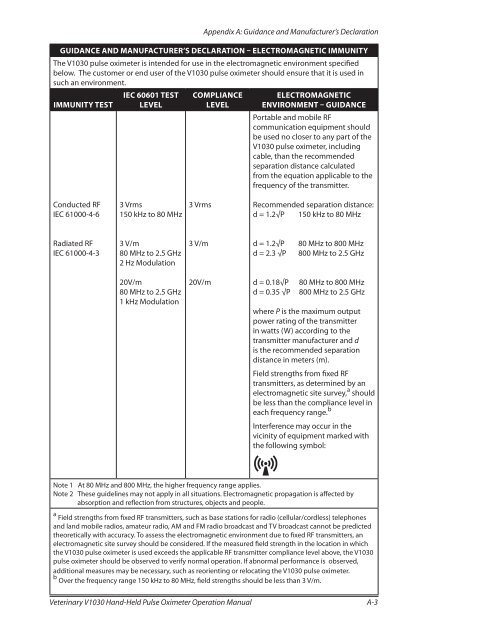
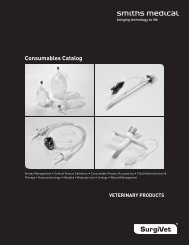
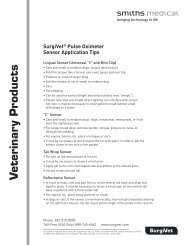
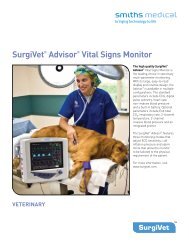
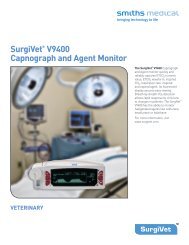
![Redemption Form [PDF] - SurgiVet](https://img.yumpu.com/37386077/1/190x245/redemption-form-pdf-surgivet.jpg?quality=85)
![Redemption Form [PDF] - SurgiVet](https://img.yumpu.com/37386066/1/190x245/redemption-form-pdf-surgivet.jpg?quality=85)
